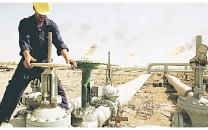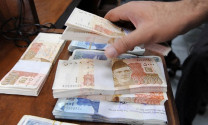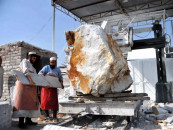Will tariffs catalyse renaissance?
Trump's trade blitz offers harsh wake-up call, and golden opportunity

After witnessing rapid transformations on the global economic landscape in recent years – particularly in 2025 following Donald Trump's re-election as US President – I find myself rephrasing an old Chinese proverb to better capture today's reality: "When America sneezes, the world catches a cold."
In 2025, that cold has morphed into a sharp economic flu – and Pakistan, like many other emerging economies, is feeling the full brunt of the shiver. The United States' latest volley of tariffs, launched under the banner of "strategic economic resilience" and dubbed "Reciprocal Tariffs" by Trump on what he calls "Liberation Day," may not be directly targeting Pakistan, but the indirect impact is both real and damaging.
The Office of the United States Trade Representative's most recent National Trade Estimate Report paints an unambiguous picture: global supply chains are being re-engineered with relentless precision. Compliance costs are rising sharply. Technical barriers are multiplying. Market entry thresholds are being lifted to unprecedented heights.
For Pakistan – where textiles alone make up over 60% of total exports and provide livelihoods to nearly 40% of industrial workers – these changes are more than a distant policy concern. They are existential.
The world is changing. Will Pakistan keep up – or be left behind with outdated business models?
Tariffs by stealth
Unlike the frontal trade assault deployed against China, Pakistan faces, what can be called, "tariffs by stealth." These come disguised as regulatory hurdles, phytosanitary requirements, traceability standards, and new certification mandates. Each one acts as an invisible tariff.
The textile sector – the backbone of Pakistan's export economy – has been hit the hardest. Readymade garments, bed sheets, denim, and towels are now subjected to enhanced origin verification, sustainability audits, and strict labour rights certifications. According to internal assessments, these measures have inflated compliance costs for Pakistani exporters by 12% to 18% in just the first quarter of 2025. Margins are being quietly eroded, container by container.
Agriculture fares little better. Pakistani mangoes, kinnows, and seafood must now clear labyrinthine phytosanitary inspections, often languishing at US ports beyond shelf life. With each delayed shipment, Pakistan haemorrhages competitiveness to nimble rivals like Peru and Vietnam.
In Sialkot, the sports goods sector is being nudged out by new technical conformity standards that inherently favour high-end branded manufacturers – an area where Pakistani firms have long underinvested.
Even Pakistan's growing services sector isn't immune. Freelancers and IT exporters, who collectively send over $2.5 billion in remittances each year, now navigate a thicket of cybersecurity compliance, data localisation uncertainties, and banking regulations that undermine trust and predictability.
The cumulative result is a slow but steady throttling of Pakistan's export machine – death by a thousand paper cuts.
A moment of reckoning
Yet, within this turbulence lies a sliver of opportunity. America isn't merely isolating China; it's actively scouting for new sourcing partners. The term "China+1" has become a mantra in US corporate strategy circles. Bangladesh, Vietnam, and Mexico are already positioning themselves. Pakistan, inexplicably, lags behind.
This is strategic malpractice. Pakistan boasts lower labour costs than Vietnam, a larger English-speaking workforce than Bangladesh, and a richer agricultural base than Mexico. Yet, we stumble at the starting line because of outdated business models, dilapidated infrastructure, regulatory inefficiencies, and a failure to present a compelling national brand.
Imagine this: if Pakistan captures just 5% of the US apparel trade that's shifting away from China – a market worth around $200 billion – that would generate $10 billion in new exports. That's enough to slash our trade deficit by nearly a third.
In organic food, the US market is poised to reach $70 billion by 2027. Pakistan's share? A paltry 0.02%. With minimal investment in organic certifications and cold chain logistics, we could grow our exports in this segment to $500 million in just three years.
The cost of inaction is not theoretical. It's visible in the shuttered factories, unemployed youth, and dwindling reserves we're already grappling with.
What must be done?
It is time to stop admiring the problem and start solving it. Three decisive actions are urgently needed:
First, we must radically simplify export compliance systems. The fact that a Pakistani exporter waits 90-120 days for documentation that Vietnam processes in under a week is a national embarrassment. A real-time, single-window digital export clearance system – with electronic signatures and strict timelines – must be deployed within five months, not five years. Second, we must invest heavily in branding and market access. "Made in Pakistan" should not evoke images of cheap labour and suspect quality. It must stand for reliability, sustainability, and ethical production. The government must earmark at least 1% of GDP for export marketing assistance, as South Korea once did when it transformed from a war-torn backwater into an export powerhouse.
Third, sector-specific strategies must replace the current scattershot approach. In textiles, we must shift towards technical textiles – sportswear, fire-retardant fabrics, medical garments – where margins are double those of conventional garments.
In agriculture, certification agencies must be revamped to global standards, allowing exporters to tap into the $200 billion premium food market. In IT, Pakistan must negotiate bilateral digital trade agreements that guarantee data security and cross-border freelancing protections.
These are not pipedreams. Bangladesh grew its textile exports from $10 billion to $45 billion in a decade through exactly such focused intervention. Mexico captured over $100 billion of US manufacturing reshoring by offering speed and certainty to buyers. There is no reason Pakistan cannot do the same – except our own inertia.
Rhetoric must meet reality
While policymakers continue to spout platitudes about "export-led growth," the reality is that our global trade footprint is shrinking. Pakistan's share of global exports has fallen from 0.18% in 2005 to just 0.13% in 2024. Ethiopia – a country only recently emerging from civil war – is outperforming us on the export front.
This is not just a failure of strategy. It's a failure of national ambition. The tectonic plates of global commerce are shifting. Supply chains are fragmenting. New opportunities are opening. The digital economy is erasing borders. And yet, Pakistan risks being left on the sidelines.
A final call
Pakistan must do more than merely survive this global reset. We must lead in select niches. We must see the cracks in the old order not as threats, but as entry points. The time has come to declare a national export emergency – a coordinated push from government, industry, and civil society to rewire our trade model for the 21st century.
If we act decisively, the American tariffs of 2025 need not be a death sentence. They could become the inflection point for a long overdue export renaissance. But we must act – and act now.
THE WRITER IS A COMMODITIES CONNOISSEUR, TRADE EXPERT WITH OVER 40 YEARS OF EXPERIENCE IN EXPORTS, AND FORMER VICE PRESIDENT OF KCCI




















COMMENTS
Comments are moderated and generally will be posted if they are on-topic and not abusive.
For more information, please see our Comments FAQ